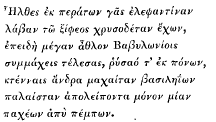Published online by Cambridge University Press: 25 January 2012
Through the activity and skill of native and European excavators in Egypt during the last few years, our knowledge of Egyptian archaeology has been much increased; and nearly every collection of Egyptian antiquities in Europe has been substantially enlarged. Curiously enough, however, the contents of certain sections of these collections have remained without many additions; and among such sections must be placed the weapons of war of the ancient Egyptians, who lived before the eighteenth dynasty. There are in the various Egyptian collections a comparatively large number of bronze daggers and knives, and other weapons which are supposed to have been made during the rule of the eighteenth or nineteenth dynasty over Egypt; but, in many cases, the proofs that would make the belief a certainty are wanting. When, however, by means of inscriptions, or the knowledge of the circumstances which attended the discovery of certain bronzes, we can fix their date beyond all doubt, it is most important to put such facts on record. The object of the following notes is to describe some of the most interesting of Egyptian bronze weapons now known to us.
page 84 note a Lepsius, Denhniiler, Bd. iii. Bl. 2 a.
page 85 note a See Revue Générate de l'Architecture, ed. Daly, 1860, col. 99 ff.
page 86 note a Evans, Bronze Implements, pp. 280, 293.
page 86 note b Catalogue, No. 5421 a.
page 86 note c Vol. xxiii., p. 298.
page 88 note a See also Evans, The Ancient Bronze Implements of Great Britain, p. 298. M. O. Montelius is doubtful if this weapon is really Egyptian. See L'Anthropologie, t. i. p. 43.
page 89 note a The Greek writer Agatharchides, who lived about one hundred years before Christ, states thai copper or bronze tools, which had been used by the ancient workers in some ancient copper mines, were discovered in his day. See Evans, Ancient Stone Implements of Great Britain, p. 6.
page 89 note b “Die Bronze, die Legierung von Kupfer und Zinn, die später eine so grosse Rolle spielte, schcint zur Zeit der vierten Dynastic noch nicht bekannt gewesen zu sein. Auch ist es nicht wahrscheinlich, dass die Darstellung der Bronze in Aegypten erfunden wurdo, vielmehr lässt sich annehmen, dass dieselbe erst zur Zeit der zwölften, vielleicht erst zur Zeit der achtzehnten Dynastie durch den Handel eingeführt wurde.” Die Geschichte des Eisens, Braunschweig, 1884, s. 78. On the other hand, however, the conclusions arrived at by M. Oscar Montélius (in Anthropologie, ed. MM. Cartailhac, Hamy, Topinard, art. L'Age du Bronze en Egypte, t. i. No. 1, p. 38). with respect to the age of the use of bronze in Europe are as follows: “que les Egyptiens, pendant tout le temps de l'Ancion Empire, et probablement jusqu'a 1500 ans avant Jésus Christ, ne connaissaient pas l'usage du fer et n'employaient que du bronze pour leurs armes et leur instruments; quo l'âge du bronze done a continué en Egypte jusqu'à la dite époque, et que le fer encore vers la fin du deuxième millénaire avant Jésus Christ n'a pas entièrement remplacé le bronze pour la confection déarmes et d'instruments tranchants.”
page 89 note c Lepsius, Denkmäler, ii. 137 c.
page 90 note a Lepsius, Les Métaux dans les Inscriptions Egyptiennes, p. 45.
page 90 note b Aegyptische Zeitschrift, 1873, s. 120.
page 92 note a Compare the fragment of a note addressed by Alcaeus (No. 33, ed. Bergk) to his brother Antimenidas, who, according to Strabo (ed. Didot, p. 527, 1. 42), had served as an auxiliary among the Babylonians.

“You are back from the ends of the earth, bearing a sword with ivory handle set in gold, in token of the great deed you achieved among the Babylonians,” etc.
I owe this reference to the kindness of Mr. A. S. Murray.